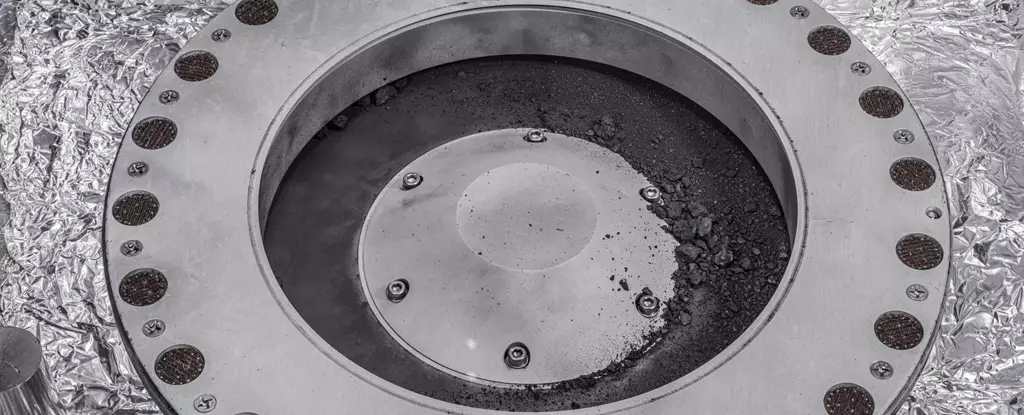A groundbreaking scientific achievement has been made by NASA’s OSIRIS-REx mission, as researchers have confirmed that a sample collected from the 4.5-billion-year-old asteroid Bennu contains a significant amount of water and carbon. This remarkable finding adds further support to the prevailing theory that life on Earth may have originated from extraterrestrial sources. These findings were revealed by NASA Administrator Bill Nelson during a press event held at the Johnson Space Center in Houston, where the first images of the precious sample were unveiled.
The sample collected from Bennu is the largest carbon-rich asteroid sample ever brought back to Earth, according to NASA. Carbon accounted for nearly five percent of the sample’s total weight and was detected in both organic and mineral form. Furthermore, the water was found to be locked inside the crystal structure of clay minerals. The presence of these essential elements reinforces the belief that Earth’s oceans, lakes, and rivers were formed billions of years ago when water-carrying asteroids collided with our planet, making it habitable. Carbon, the basis of all life on Earth, forms vital bonds with other elements, giving rise to proteins, enzymes, as well as the building blocks of DNA and RNA.
A Precious Payload from an Ancient Artifact
Bennu, named after an ancient Egyptian deity, is an extraordinary celestial body that has been preserved in the vacuum of space for billions of years. Its remarkable composition, combined with its orbital proximity to Earth, makes Bennu an ideal target for scientific study. The ease of reaching Bennu’s orbit, which intersects with our own, made the OSIRIS-REx mission possible, in contrast to the challenges posed by reaching asteroids in the Asteroid Belt located between Mars and Jupiter. Moreover, a deeper understanding of its composition may prove crucial if humanity ever needs to redirect or mitigate its potential impact on Earth.
Scientist Daniel Glavin describes the collected sample as an “astrobiologist’s dream.” However, this is just the beginning of a comprehensive scientific analysis, as much more work lies ahead. The sample will be shared with laboratories around the world for further examination and experimentation. The initial analysis was conducted using advanced scientific techniques such as scanning electron microscopy and X-ray computed tomography. These findings could have far-reaching implications for our understanding of the origins of life and the potential for extraterrestrial life beyond our planet.
While the OSIRIS-REx mission was not the first to retrieve samples from an asteroid, it stands out due to the significant quantity of sample material collected. Estimations suggest that approximately 250 grams (half a pound) of material were carefully brought back to Earth, which significantly surpasses the amounts returned by previous missions. In comparison, Japan’s Hayabusa2 mission succeeded in returning only 5.4 grams of celestial dust. OSIRIS-REx’s achievement enables researchers to conduct in-depth analyses and experiments that were previously unfeasible, opening up new avenues of scientific exploration.
Unforeseen Challenges and Surprising Opportunities
During the collection process in October 2020, an unexpected obstacle arose when a flap designed to seal the sample mechanism became lodged open. Consequently, some of the sample material flowed into another compartment. However, this “problem” has proven to be a fortuitous one, as it indicates the abundance of sample material. The meticulous study and examination of the collected particles, including those that accumulated on top of the sample collecting mechanism, have been the primary focus thus far. Subsequent inspections of the remaining sample will be carried out in the near future.
NASA remains committed to preserving this invaluable sample for future study and analysis. At least 70 percent of the sample will be carefully preserved at the Johnson Space Center in Houston, taking inspiration from the practices initiated during the Apollo era. This will ensure that future generations of scientists will have access to the material, enabling them to utilize innovative technologies and techniques yet to be developed. A portion of the sample will also be sent for public display at esteemed institutions like the Smithsonian Institution, Space Center Houston, and the University of Arizona, creating awe-inspiring exhibits to inspire and educate the general public.
The discovery of water and carbon on the ancient asteroid Bennu heralds a significant breakthrough in our understanding of the origins of life on Earth. NASA’s OSIRIS-REx mission has provided scientists with an unprecedented opportunity to study this remarkable celestial body. As researchers continue to analyze the sample material, further insights into the formation of our planet, the building blocks of life, and the possibilities of extraterrestrial existence will undoubtedly emerge. This milestone achievement fuels our curiosity about the cosmos and reinforces the belief that the answers to some of the universe’s most profound mysteries may lie within our reach.


Leave a Reply